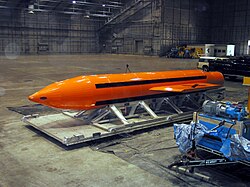Bomb

A bomb is any of a range of explosive devices that typically rely on the exothermic chemical reaction of an explosive material to produce an extremely sudden and violent release of energy. The word comes from the Greek word βόμβος (bombos), an onomatopoetic term with approximately the same meaning as "boom" in English. A nuclear weapon employs chemical-based explosives to initiate a much larger nuclear-based explosion.
The term "bomb" is not usually applied to explosive devices used for civilian purposes such as construction or mining, although the people using the devices may sometimes refer to them as bombs. The military use of the term "bomb", or more specifically aerial bomb, typically refers to airdropped, unpowered explosive weapons most commonly used by air forces and naval aviation. Other military explosive weapons not classified as "bombs" include grenades, shells, depth charges (used in water), warheads when in missiles, or land mines. In unconventional warfare, "bomb" can refer to any of a limitless range of explosive devices used as or offensive weapons.
Types

Experts commonly distinguish between civilian and military bombs. The latter are almost always mass-produced weapons, developed and constructed to a standard design out of standard components and intended to be deployed in a standardexplosive device]]s (IEDs). IEDs are divided into three basic categories by basic size and delivery. Type 1 IEDs are hand-carried parcel or suitcase bombs, type 2 are "suicide vests" worn by a bomber, and type 3 devices are vehicles laden with explosives to act as large-scale stationary or self-propelled bombs, also known as VBIED (vehicle-borne IEDs).
Improvised explosive materials are typically very unstable and subject to spontaneous, unintentional detonation triggered by a wide range of environmental effects ranging from impact and friction to electrostatic shock. Even subtle motion, change in temperature, or the nearby use of cellphones or radios, can trigger an unstable or remote-controlled device. Any interaction with explosive materials or devices by unqualified personnel should be considered a grave and immediate risk of death or dire injury. The safest response to finding an object believed to be an explosive device is to get as far away from it as possible.
Atomic bombs are based on the principle of nuclear fission, that when a large atom splits it releases a massive amount of energy. Hydrogen bombs use the energy from an initial fission explosion to create an even more powerful fusion explosion.
The term dirty bomb refers to a specialized device that relies on a comparatively low explosive yield to scatter harmful material over a wide area. Most commonly associated with radiological or chemical materials, dirty bombs seek to kill or injure and then to deny access to a contaminated area until a thorough clean-up can be accomplished. In the case of urban settings, this clean-up may take extensive time, rendering the contaminated zone virtually uninhabitable in the interim.
The power of large bombs is typically measured in megatons of TNT (Mt). The most powerful bombs ever used in combat were the two atomic bombs dropped by the United States to attack Hiroshima and Nagasaki, and the most powerful ever tested was the Tsar Bomba. The most powerful non-nuclear bombs are the United States Air Force's MOAB (officially Massive Ordnance Air Blast, or more commonly known as the "Mother of All Bombs") and the Russian "Father of All Bombs".[1]
It goes boom.
Blast seat
In forensic science, the point of detonation of a bomb is referred to as its blast seat, seat of explosion, blast hole or epicenter. Depending on the type, quantity and placement of explosives, the blast seat may be either diffuse or concentrated (i.e., an explosion crater).[2]
A crater is usually a good indication that an explosion was caused by an explosive device. Other types of explosions, such as dust or vapor explosions, do not cause craters or even have definitive blast seats.[2]
References
This article needs additional citations for verification. (April 2007) |
- ^ Solovyov, Dmitry (2007-09-12). "Russia tests superstrength bomb, military says". Reuters. Retrieved 2008-06-02.
- ^ a b Walsh, C. J. (2008). "Blast seat". In Ayn Embar-seddon, Allan D. Pass (eds.) (ed.). Forensic Science. Salem Press. p. 149. ISBN 978-1587654237.
{{cite book}}:|editor=has generic name (help)
External links
- FAS.org Bombs for Beginners
- MakeItLouder.com How a bomb functions and rating their power
